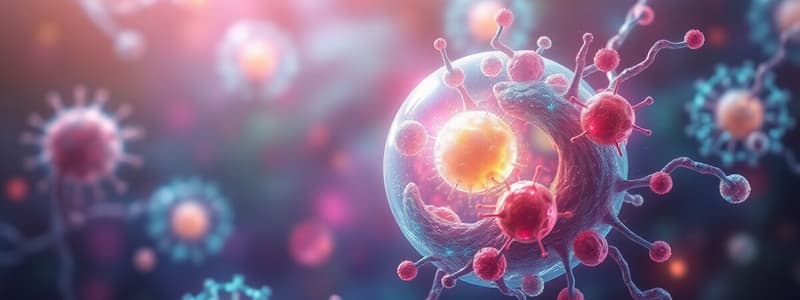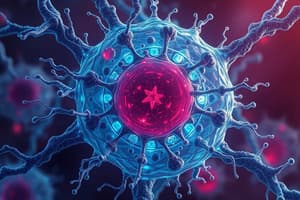Podcast
Questions and Answers
What is the function of protoplasm?
What is the function of protoplasm?
- To send signals throughout the body
- To provide a medium for intracellular transport (correct)
- To remove waste from the cell
- To create hormones for the body
What two things does the human body contain?
What two things does the human body contain?
- Specialized cells and organs
- Specialized cells and tissues (correct)
- Specialized cells and skin
- Specialized blood and bones
What are sex cells also referred to as?
What are sex cells also referred to as?
- Somatic cells
- Gamete cells
- Reproductive cells (correct)
- Plasma cells
Which of the following is considered a basic part of the cell?
Which of the following is considered a basic part of the cell?
What is the function of the cell membrane?
What is the function of the cell membrane?
What is something that the cell membrane allows?
What is something that the cell membrane allows?
The cell membrane is known to be what?
The cell membrane is known to be what?
What kind of permeability is the cell membrane known to have?
What kind of permeability is the cell membrane known to have?
What are primary substances that make up cell membranes?
What are primary substances that make up cell membranes?
What are lipids formed by?
What are lipids formed by?
What is the outer surface of a cell mostly formed of?
What is the outer surface of a cell mostly formed of?
What are the inner surfaces of cell membranes formed by?
What are the inner surfaces of cell membranes formed by?
What can proteins act as in the lipid bilayer?
What can proteins act as in the lipid bilayer?
To what kind of gradient does diffusion move particles/solutes?
To what kind of gradient does diffusion move particles/solutes?
What affects the degree of diffusion?
What affects the degree of diffusion?
How will a solvent move in osmosis?
How will a solvent move in osmosis?
What is the measure of the tendency of water to move by osmosis called?
What is the measure of the tendency of water to move by osmosis called?
What is it called when too much water moves out of the cell and it shrinks?
What is it called when too much water moves out of the cell and it shrinks?
What is the process of a cell swelling and bursting due to too much water called?
What is the process of a cell swelling and bursting due to too much water called?
What type of diffusion occurs when a carrier molecule moves substances into or out of cells from high concentration to low concentration?
What type of diffusion occurs when a carrier molecule moves substances into or out of cells from high concentration to low concentration?
Does facilitated diffusion require energy?
Does facilitated diffusion require energy?
In what direction does Active Transport move a substance?
In what direction does Active Transport move a substance?
What is required for active transport?
What is required for active transport?
What is endocytosis
What is endocytosis
What is the form of endocytosis meaning “cell eating” called?
What is the form of endocytosis meaning “cell eating” called?
What is release of seretions from cells called?
What is release of seretions from cells called?
The largest and most visible stucture inside a cell is called what?
The largest and most visible stucture inside a cell is called what?
What is contained inside the nucleolus?
What is contained inside the nucleolus?
What role does the cytoplasm have?
What role does the cytoplasm have?
What are the internal structures within the cell that carry out all functions for humans called?
What are the internal structures within the cell that carry out all functions for humans called?
Which of the following is included as an organelle?
Which of the following is included as an organelle?
What is the point of centrioles?
What is the point of centrioles?
What kind of projections are cilia?
What kind of projections are cilia?
What is the point of cilia?
What is the point of cilia?
What is the tail-like microtubule structure called?
What is the tail-like microtubule structure called?
What does a flagellum do?
What does a flagellum do?
What is the function of ribosomes?
What is the function of ribosomes?
What is manufactured in the endoplasmic reticulum?
What is manufactured in the endoplasmic reticulum?
For what purpose should you think of the Golgi Apparatus?
For what purpose should you think of the Golgi Apparatus?
As what type of system do lysosomes function?
As what type of system do lysosomes function?
Peroxisomes are similar to what?
Peroxisomes are similar to what?
Where are peroxisomes found in high concetrations?
Where are peroxisomes found in high concetrations?
As what for a cell does the mitochondria function?
As what for a cell does the mitochondria function?
In what are you likely to find the DNA?
In what are you likely to find the DNA?
What type of process is the ongoing process of cell renewal?
What type of process is the ongoing process of cell renewal?
What does protoplasm provide a medium for?
What does protoplasm provide a medium for?
What are somatic cells?
What are somatic cells?
Which of the following is found in high concentrations in the liver?
Which of the following is found in high concentrations in the liver?
Which of the following best describes cilia?
Which of the following best describes cilia?
What is the effect of cyanide on the body?
What is the effect of cyanide on the body?
Flashcards
Protoplasm
Protoplasm
A viscous liquid matrix that supports all internal cellular structures
Tissues
Tissues
Cells with a common job that grow close to each other
Organs
Organs
Groups of tissues that all perform interrelated jobs
Homeostasis
Homeostasis
Signup and view all the flashcards
Sex Cells
Sex Cells
Signup and view all the flashcards
Somatic Cells
Somatic Cells
Signup and view all the flashcards
Cell Structure
Cell Structure
Signup and view all the flashcards
Cell Membrane
Cell Membrane
Signup and view all the flashcards
Extracellular
Extracellular
Signup and view all the flashcards
Intracellular
Intracellular
Signup and view all the flashcards
Lipids and Proteins
Lipids and Proteins
Signup and view all the flashcards
Bilayer
Bilayer
Signup and view all the flashcards
Selective permeability
Selective permeability
Signup and view all the flashcards
Electrolytes
Electrolytes
Signup and view all the flashcards
Diffusion
Diffusion
Signup and view all the flashcards
Degree of Diffusion
Degree of Diffusion
Signup and view all the flashcards
Osmosis
Osmosis
Signup and view all the flashcards
Crenation
Crenation
Signup and view all the flashcards
Lysis
Lysis
Signup and view all the flashcards
Facilitated diffusion
Facilitated diffusion
Signup and view all the flashcards
Active Transport
Active Transport
Signup and view all the flashcards
Endocytosis
Endocytosis
Signup and view all the flashcards
Phagocytosis
Phagocytosis
Signup and view all the flashcards
Pinocytosis
Pinocytosis
Signup and view all the flashcards
Exocytosis
Exocytosis
Signup and view all the flashcards
Nucleus
Nucleus
Signup and view all the flashcards
Nucleoplasm
Nucleoplasm
Signup and view all the flashcards
Cytoplasm
Cytoplasm
Signup and view all the flashcards
Organelles
Organelles
Signup and view all the flashcards
Centrioles
Centrioles
Signup and view all the flashcards
Cilia
Cilia
Signup and view all the flashcards
Flagellum
Flagellum
Signup and view all the flashcards
Ribosomes
Ribosomes
Signup and view all the flashcards
Endoplasmic Reticulum
Endoplasmic Reticulum
Signup and view all the flashcards
Golgi Apparatus
Golgi Apparatus
Signup and view all the flashcards
Lysosomes
Lysosomes
Signup and view all the flashcards
Peroxisomes
Peroxisomes
Signup and view all the flashcards
Mitochondria
Mitochondria
Signup and view all the flashcards
Cytosol
Cytosol
Signup and view all the flashcards
Remodeling
Remodeling
Signup and view all the flashcards
Meiosis
Meiosis
Signup and view all the flashcards
Mitosis
Mitosis
Signup and view all the flashcards
Tissues
Tissues
Signup and view all the flashcards
Epithelial Tissue
Epithelial Tissue
Signup and view all the flashcards
Basement Membrane
Basement Membrane
Signup and view all the flashcards
Connective Tissue
Connective Tissue
Signup and view all the flashcards
Muscle Tissue
Muscle Tissue
Signup and view all the flashcards
Study Notes
- Cells are fundamental to the human body
- In simple life forms like amoebas, a single cell is the entire organism
- The human body contains billions of specialized cells
Protoplasm
- A viscous liquid matrix supporting internal cellular structures
- Each cell contains a mass of this colorless substance
- It facilitates intracellular transport of nutrients, signaling molecules, ATP, and proteins
Tissue and Homeostasis
- Tissues are cells with a shared function growing in close proximity
- Organs are groups of tissues performing related jobs
- Homeostasis is the body's stable internal environment
- A disruption of homeostasis impacts the organism
Two Types of Cells
- Sex cells (germ or reproductive cells) include sperm in males and oocytes (eggs) in females
- Somatic cells are all other body cells
- Somatic cells are the main focus
Three Basic Parts of A Cell
- A cell consists of a cell membrane, a nucleus and cytoplasm
- Organelles are specialized cell structures that perform necessary functions
Cell Membrane
- The cell membrane controls the movement of substances in and out
- Extracellular located outside the cells
- Intracellular means situated inside cells
- Atoms compose molecules and consist of protons (positive charge), electrons (negative charge), and uncharged neutrons
- It allows selective communication between intracellular and extracellular compartments, assisting in cell movement
- It provides structure
- The cell membrane facilitates biological activities.
- Detects and transmits signals from outside
- Adheres to other cells to form tissues
- Selectively permeable, allowing certain elements to pass while blocking others
Lipids and Proteins
- Lipids and proteins are primary in cell membranes,
- Typically a phospholipid bilayer
- Phosphate portion forms the outer surface.
- Fatty acid portion forms the inner surface.
- Proteins periodically interrupt the lipid bilayer of cells
- These act as transporters, signal receptors, channels, and ion channels
Membrane Permeability
- A cell membrane allows selective passage to maintain stability
- Extracellular and intracellular separation does helps maintain stability
- Enzymes, sugar, and electrolytes is able to enter in freely
- Electrolytes conduct electricity when dissolved in a solvent like water.
Cell Transport Mechanism
- Mechanisms allowing material passage through the cell membrane including diffusion, osmosis, facilitated diffusion, active transport, endocytosis, and exocytosis
Diffusion
- Diffusion involves the movement of particles, or solutes from an area of high concentration to low concentration
- Diffusion depends on the membrane's permeability and concentration gradient
- Small molecules diffuse more easily, and watery solutions diffuse faster than thicker solutions
Osmosis
- Osmosis involves the movement of a solvent from low to high concentration through a membrane
- Osmotic pressure is the measure of water's tendency to move across a membrane
- Crenation is cell shrinkage from water loss
- Lysis is cell swelling and bursting from water gain
Facilitated Diffusion
- Facilitated diffusion involves a carrier molecule moving substances from areas of high concentration to areas of low concentration
- This process does not needs energy.
- The amount molecules transported is directly related to substance concentrations.
Active Transport
- Active transport is the substance moment a concentration gradient
- It requires energy and often a carrier mechanism
- Transport is opposite of diffusion
- The mechanism exchange substances
Filtration
- With filtration water moves out of plasma a cross the capillary membrane in the interstitial space
- Hydrostatic pressure drives this
- Oncotic force pulls water back from interstitial space.
Endocytosis & Exocytosis
- Endocytosis involves material uptake through membrane forming vesicle within cell protoplasm
- Phagocytosis is a cell eating solid particles
- Pinocytosis is cell drinking liquids
- Exocytosis releases cell secretions from vesicles binding with the membrane
Nucleus Structure
- The largest, most visible structure, containing DNA is the Nucleus
- Without the nucleus, the cell disintegrates in 3-4 months
- The nucleus holds genetic instructions used to synthesize proteins to determine cell function and structure
- Enclosed in a double membrane with inner and outer lipid layers its typically round
- It enables the exit of specific molecules with protein lining
Nucleoplasm
- Nucleoplasm suspends the nucleolus (with RNA and protein, site of ribosome formation) and chromatin
- Chromatin of coiled DNA and protein then condense
Cytoplasm
- Cytoplasm contains all cellular material between the cell membrane and nucleus
- The setting of chemical reactions
- It comprises most of cells volume
- The space where organelles are stores
- Cytosol is the fluid portion containing water, glucose, and ATP
Organelles
- Important organelles including centrioles (for spindle apparatus), cilia (hair-like structures moving materials) and flagella (tail-like structures, sperm motility)
Ribosomes
- It contains RNA and protein interacting with RNA from cell parts for protein formation, mainly in the endoplasmic reticulum
Endoplasmic Reticulum
- It manufactures specific proteins and fats (or lipid) through membranes
Golgi Apparatus
- It associates carbohydrates with large protein groups
Lysosomses & Peroxisomes
- Lysosomes has enzymes work as digestive system
- Peroxisomes are like that of lysosomes but detoxes alcohol in liver
Mitochondria
- Rod-like organelles for cell metabolism center
- Use oxidation to produce Adenosine Triphosphate or ATP
- ATP stores / transfers energy cells can use
Genetic Material
- 2 Types of Genetic Material in the nucleus
- The deoxyribonucleic acid (DNA) contained in chromosomes.
- The ribonucleic acid (RNA in nucleoli ) within spherical intranuclear structures,
Cell Division Types
- Remodeling is the ongoing renewal by active cell division
- 2 parts of cell division includes meiosis and mitosis
- Meiosis are special cells dividing in sperm and ova production.
- Normal cells contain 46 chromosomes
- Sperm and ova contain only 23 chromosomes, labeled haploid
- Final organisms unit contains 46 chromosomes
- Cytokinesis divides cytoplasm of a cell precisely
- Mitosis works on all cells divide beside sperm and eggs
4 Mitosis Steps
- In Prophase centriole pairs moving
- In Metaphase chromosomes aligning equatorially with spindle fibers
- During Anaphase centromeres separate individually
- In Telophase chromosomes arrive
Types of Tissue Traits
- Tissues share is defined by a working group with same tasks
- Consisting of epithelial, muscle and nerves
Epithelial Traits
- Covering skin surfaces, linings organs, and forming glands which will secrete
- Basement membrane will always protects the layer
- Categorization of epithelial depends on cell layers amount, as well as the structure shape
Epithelial Cell Shapes
- The layer includes squamous with smooth sheets, as well as cuboids with box figure
- Lastly the columnar with skinny form factor
Other Epithelials
- Simple tissues involves 1 layer, with a singular link point
- Stratified form more than 1 layer, connected at singular point
- A single differing cell height makes pseudostratified
- A transitional involves layer of the cuboidal changed to stratified by stretching an organ
Connective Tissue
- Binding other types of tissue
- As connective proper types includes a syrup like filler space, combined with cell and fibres
- Loose involve underlying types
Supporting Tissue
- Cartilage a supporting dense structure with jelly filler
- Bones forms a hard dense framework with high protection from bone
Fluid Tissue
- Involves cells floating with a water filler for transfer
- The blood transfer red and white blood in the plazms
- Lymph drains to vessel then cardiovascular system
Muscles traits
- Overlies structures as classified function
- And it involves types either smooth or striated
- Movement is either involuntary, and/or forced
- Lastly in type with all 3 involves heart, muscle, smooth
More on Muscle
- Skeletal types are for will purposes, and moving a skeletal muscule
- Cardiac is for involuntary heart
- Smooth can be made again, is the core of core organs
Nerves
- To conduct electricity to the body
- Made of both glia and neuron cells
- Neuron carry signal
- Gila is supportive
Organs
- Tissues work is for organ tasks
- Together tissues will help to distribute the circulatory, plus others
- Together Skin protects you
Systems and Regions
- Systems involves skeleton and more like digestion
- Body separated appendicular and axial
- Appendicular includes arms
- Axial involves head and other core organs
Skull
- 5 Tissue layers are skin, muscle, bones, and marrow
- In sutures are the skull joints
- 3 Triangular neck involves other areas
Structure and Fluid
- Fluid stores organ protection
- As cavities store organs
- Diaphragm divides torso
- The membrane can be serous, that fills core in body
Studying That Suits You
Use AI to generate personalized quizzes and flashcards to suit your learning preferences.



